
I’ve been getting lots of messages over the last couple of months from people wanting to start up their own blogs. First off – that’s awesome. I’m always super flattered when someone reaches out and says they’ve read my blog and were inspired to start their own.
I already wrote a little post about how to start a blog here, but the crazy amount of questions I have hitting my inbox has pushed me to do a full re-write and add lots of detail and color. So whether you’re looking for how to start a blog, how to choose a blog name, how to set up your website, and how to make money blogging – I’ve got you covered.
Let’s get down to business.
So you want to start a blog, huh?
First things first – do not start a blog if your end goal is to make money. Just don’t. Why? Because you’ll totally hate it. Just like you’d hate doing any job if it was just for money. Blogging isn’t all trips to New York Fashion Week, free clothes, and daily photo shoots glamorous. Blogging takes a lot of time and energy – often at the expense of a personal life.
Reasons to start a blog:
- You love to write
- You love to take photos
- You are okay with self-promotion
- You love to help people
- You need a creative outlet
Reasons not to start a blog:
- To make money
- To get free things
- You want to be famous
I know I’m really short-selling the blog life here. Just trying to keep it real, people! Blogging is hard work – but blogging can also be super rewarding.
And no, I don’t mean all the free stuff.
Blogging allows you to connect with people all over the world. Blogging allows you to share your personal opinions and views. Blogging is a way to connect, to create, and to help people by sharing what makes you you.
Know why you want to start your blog before you even begin (otherwise you may start, invest, and then fizzle out). Trust me, knowing why you want to start a blog will save you a ton of time and money.
Why you don’t need a blog niche.
There are a lot of people out there who have written lots of information on why you need a blog niche. A “niche” is a specific topic you choose to blog about. But even more than that, a niche drills down to be as specific as possible.
There are positives and negatives to niche blogging. Having a niche means you have a clear focus on what you’re blogging about and who you’re blogging for. Food blogging is a niche – but southern food blogging is a “better” niche.
In theory, niche blogging is great. If you’re someone who has a niche you want to blog about it – do it.
But if you’re like me and you like a little of this and a little of that – know that you don’t need a blog niche. Having a “lifestyle” blog is great because I get to blog about everything from this awesome faux fur vest I wore to NYFW, but I also get to blog about anxiety.
Blog with a niche if that appeals to you – and don’t if it doesn’t! Blogging is like the wild west. No laws in these parts of town, partner.
Except FTC disclosure – but we’ll get to that later.
You don’t need a niche – but you do need a voice.
You don’t need a niche, but you do still need to have some sense of self. Your blog is an extension of you. Blog about things you know about and things you’re good at. Why? You’re a resource for other people who want to learn to do those same things.
It’s also super important to have a distinct voice. It always annoyed the shit out of me to hear “be yourself” as blogging advice at seminars like Create + Cultivate. But that doesn’t make it any less true. The most success you’ll have blogging comes from being exactly who you are – writing about the things you know and care about. Develop a personal brand that is you through and through and use it as your filter for every blog post, every blog layout, every Instagram, every everything.
Trust me, people will follow you for being 100% you.
How to choose a blog name.
So many people ask me how I came up with the name Blondes & Bagels.
I’m blonde and I freaking love bagels.
Yep. It was really that simple. And that’s how it should be for you too! There are a couple schools of thought on the “right” way to come up with a blog name. Most people would suggest coming up with a name that indicates your “niche.” If you’re a travel blogger for example having the words “travel” or “wanderlust” would help to indicate to potential readers what you write about. Just like a food blogger might do well with a name like “Sarah’s Southern Kitchen” (clearly indicating the blog is all about southern cooking).
Honestly I think there’s no “right” way to do much of anything blog related so you do you boo boo. There are plenty of big names in blogging like Pink Peonies where the blog name has diddly squat to do with the topic of the blog. And that’s totally okay.
Whatever you do, don’t waste hours freaking out over what to name your blog. If worst comes to worst you can always re-brand. I regret every day not starting my blog sooner. Wasting days or weeks trying to pick a name is not an effective use of time.
How to choose a blogging platform.
Once you’ve picked a topic and a name, it’s time to get your blog up and running. The two biggest names in blogging platforms are WordPress and Blogger. There are advantages and disadvantages to both, but in my experience WordPress is the platform to use if you eventually want to go “pro.” WordPress allows developers a larger range of customization. It’s the most widely used platform for “serious” bloggers.
Blondes & Bagels is a WordPress blog, so I’m going to focus on WordPress wisdom.
My #1 tip? Do not pay for a WordPress account. I’m bolding and italicizing that because I am so serious. A WordPress “Premium” account is not the same thing as self hosting – and trust me, you want to self host.
Set up a free WordPress account and let’s keep it moving.
What is self hosting and why you should self host your blog.
A WordPress account (free OR paid) is called WordPress “.com”. When you create a WordPress “.com” account you’re essentially renting a room in WordPress’ house on the internet. They give you some space, a closet to store your photos and posts. Hanging out in WordPress’ house is awesome for a while, but at some point you begin to outgrow it. You’ll eventually run out of storage space for your content – and you’ll want to start customizing and making money. WordPress “.com” doesn’t allow you to have custom themes or to run ads on your site.
Whenever you hear someone refer to WordPress “.org” they’re talking about a self hosted WordPress. This is not the same as a paid WordPress “Premium” account. Self hosting is when you pay a hosting service to host your blog for you. You own your own house on the internet and can store what you want, decorate it however you like – and start making money.
How to set up self hosting.
There are lots of hosting services out there, but I use Bluehost. I’m going to give it to you straight – I pretty much chose Bluehost because it was affordable.
I’m a simple girl and when I shop I’m typically after 1) good customer service and 2) a good deal.
I’m actually a Bluehost affiliate which means I get to share the same good price I got with my readers (and I get a small commission for every referral). If you do decide to start up your own blog you can get hosting through Bluehost for less than the price of a cup of coffee a month!
Just try and tell me that doesn’t rock. Click here or the banner below to sign up for self hosting for $3.95/month!
Honestly though my fave thing about Bluehost was that they boast an easy WordPress installation. I’m really not into complicated techy things so I appreciate it when something can be done in a click or two.
After you’ve signed up to self host, login and hit the “Install WordPress” button. Bluehost will take you through a few steps and have you ready to rock and roll in no time.
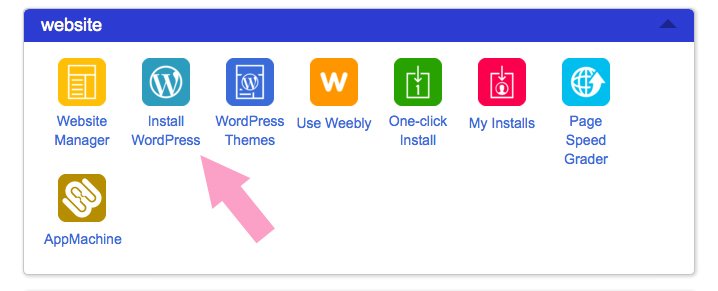
If you run into any issues make sure to use the Bluehost live chat feature! I’ve talked to so many of their customer support staff using the live chat and it’s always been quick and helpful. There hasn’t been an issue for me yet they couldn’t solve.
WordPress Basics
Let’s take a tour.
Welcome to your WordPress blog! Yours might look a tad different than mine, but the general concept should be the same. Let’s take a quick tour.
After logging in, you’ll land at your WordPress Dashboard. Your Dashboard gives you a little bit of info at a glance (like how many posts you’ve done). On the left hand side you have your menu bar.
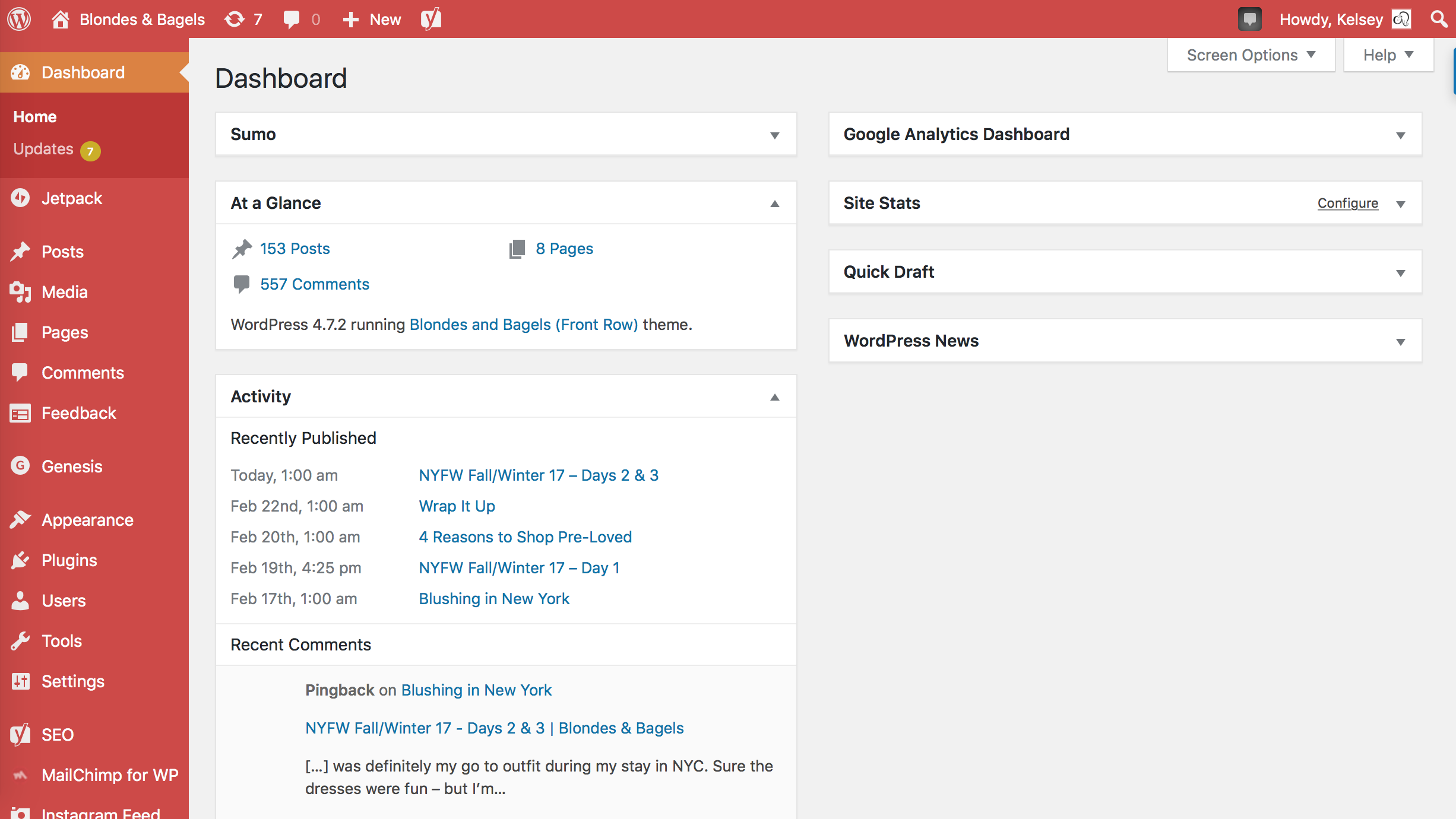
Posts is where you’ll be able to access old posts and write new ones.
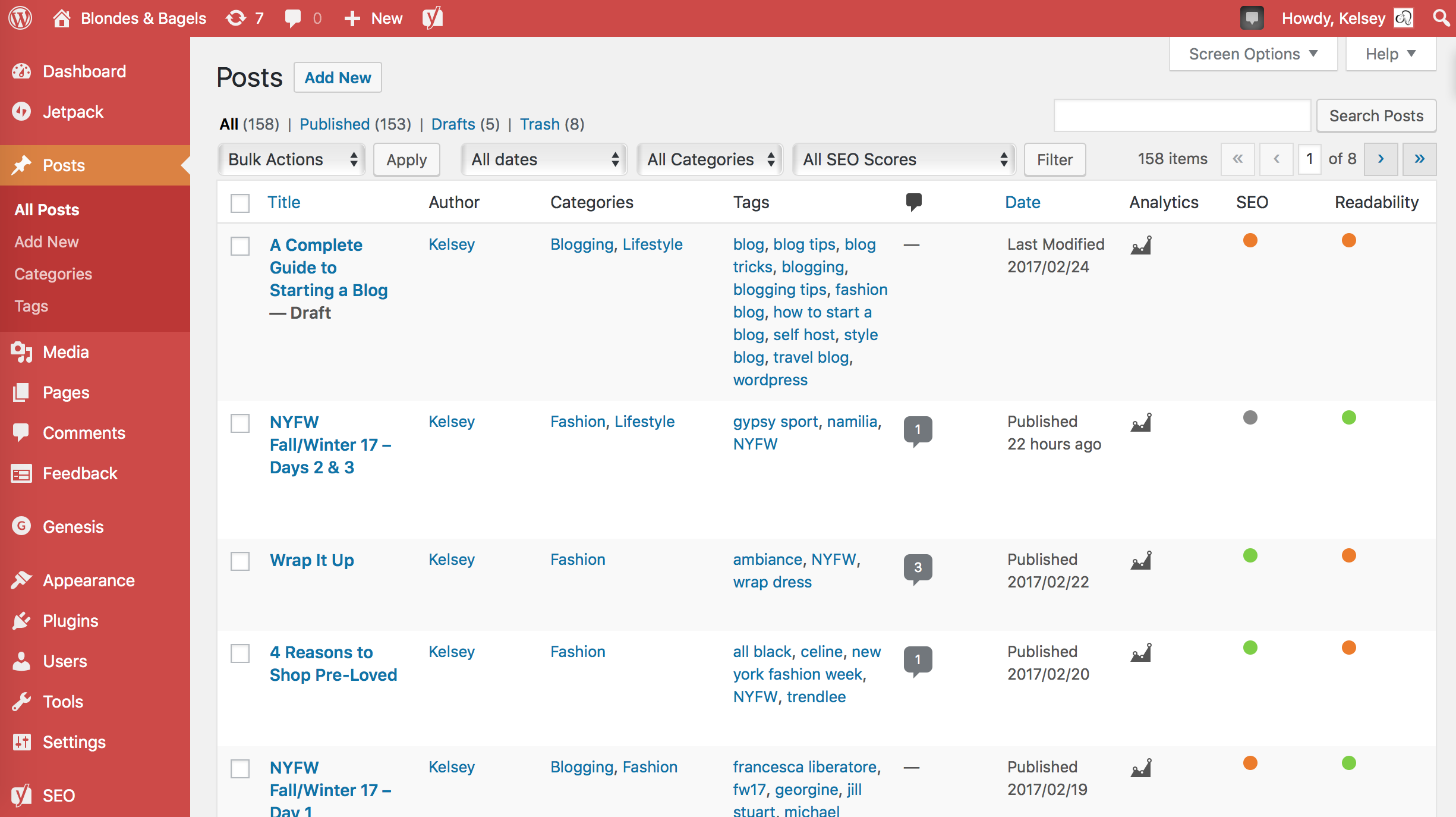
Media is your media library. This is where you’ll go to upload new images or graphics.
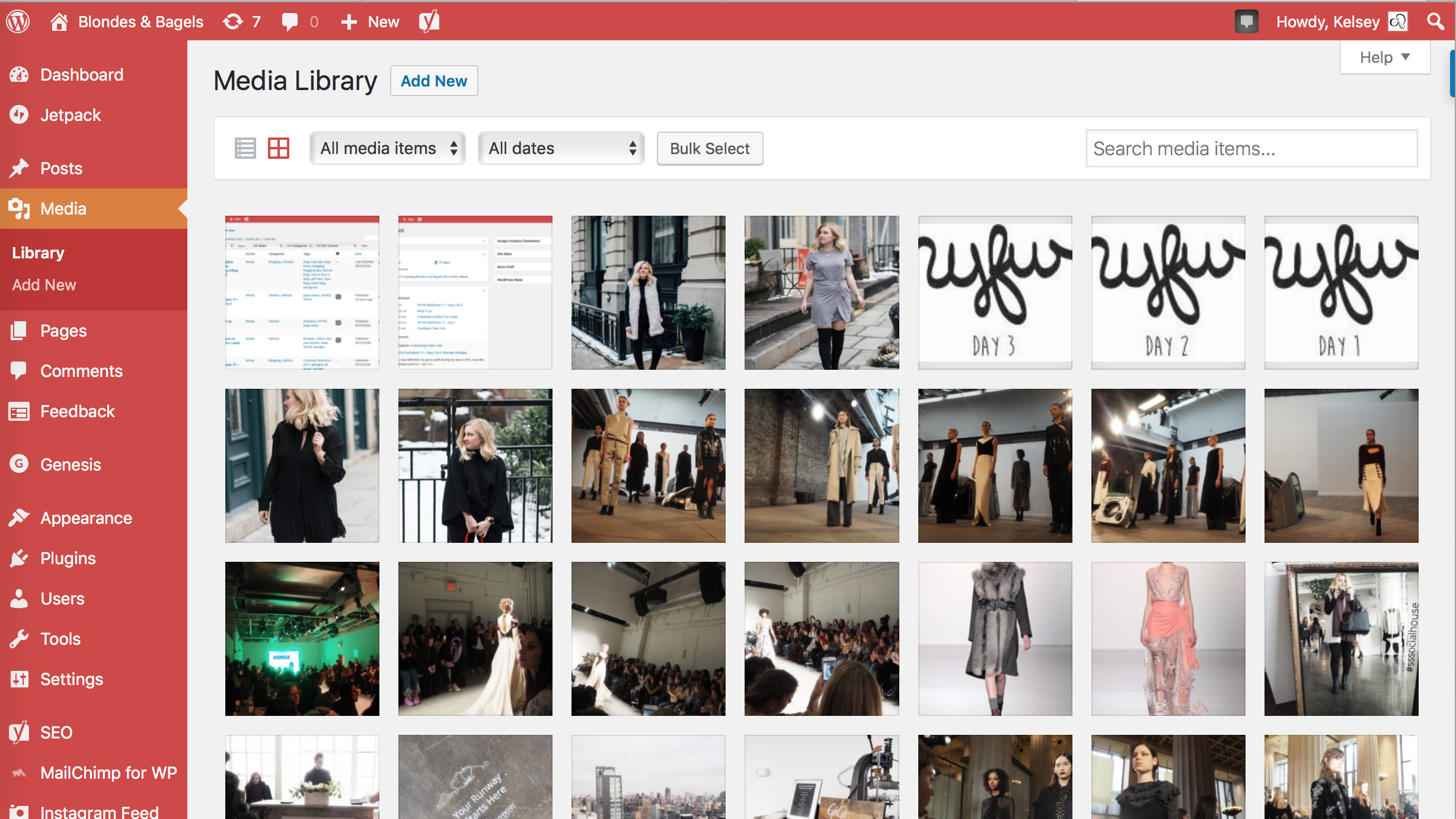
Pages is where you’ll manage all of your pages (potentially your “About” page, a “Contact” page, etc).
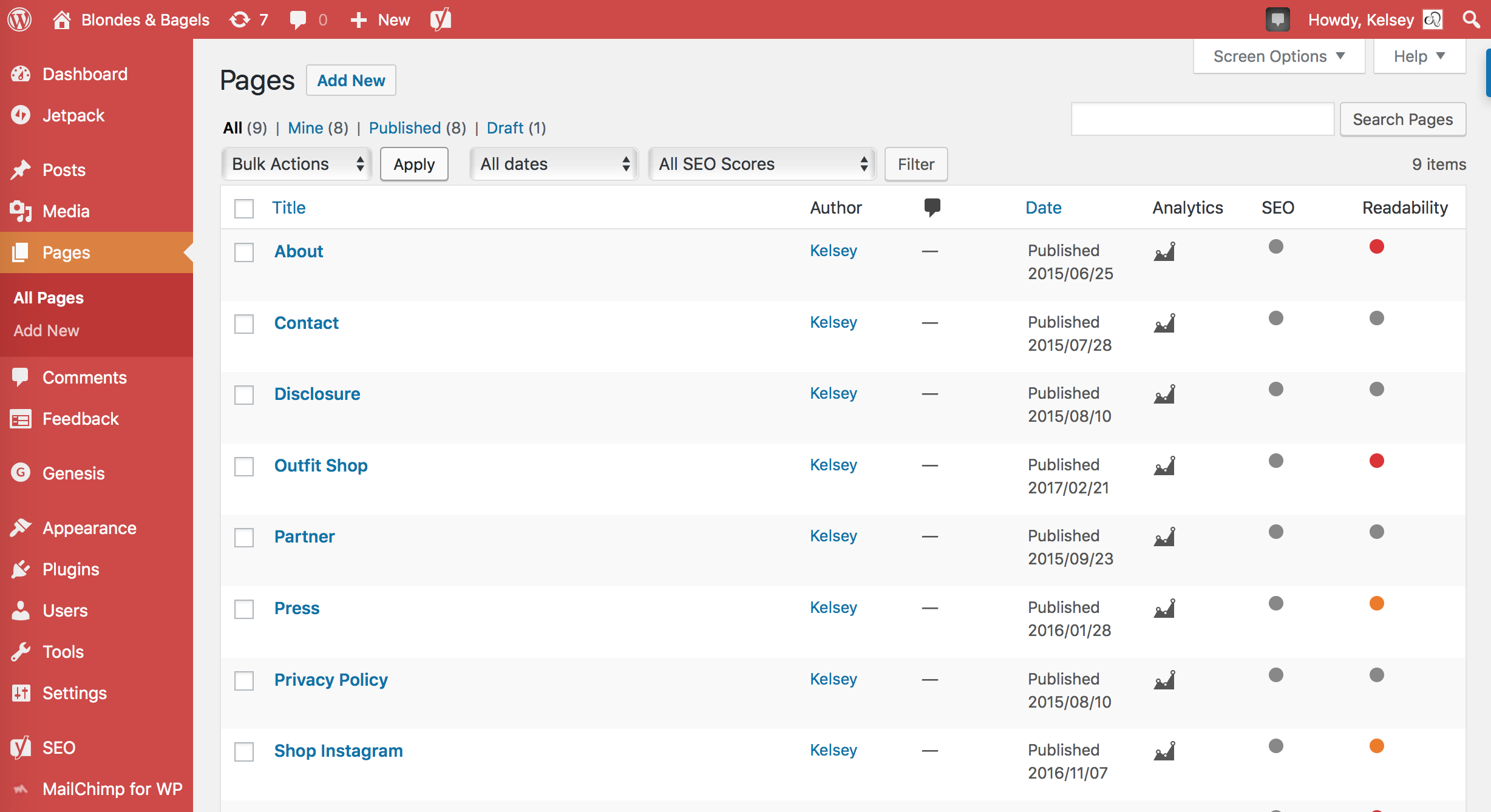
Comments is where you can view and moderate comments people leave on your blog posts.
Appearance is where you’ll customize the appearance of your blog. You can manage your themes (your blog layout), set up Widgets, or you can click “Customize” to enter the customizer and edit the look of your blog in real time.
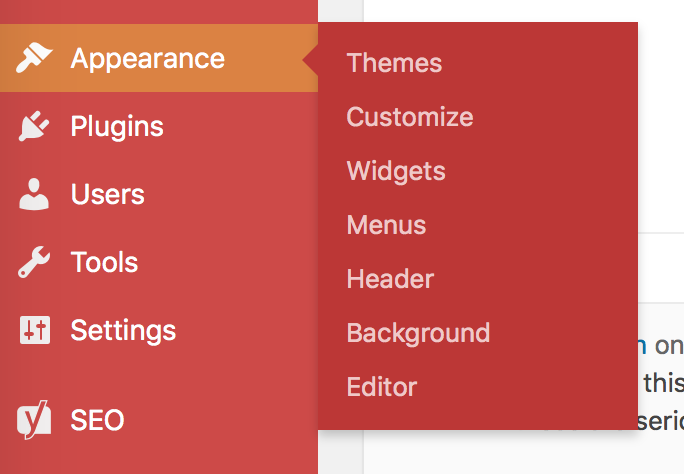
Plugins is the place to manage your current plugins and potentially install new ones. There are plugins for just about everything – Instagram feeds, analytics, SEO – you name it there’s a plugin for it. The #1 plugin I recommend is YOAST SEO. Yoast makes search engine optimization easy – and trust me you’ll love the traffic you’ll get just by doing a little SEO on each post!
I swear to you – that’s really all you need to know to get started. Once you’ve set up your theme (we’ll chat about this below) you’ll spend most of your time logging in and writing posts.
Easy peasy lemon squeezy.
Legal stuff you need to know.
While it’s up to you if you want an “About” page or a “Shop” page – there are actually some pages you are legally required to have on a blog. For any blog in which you hope to monetize, you are required to have a Privacy Policy and a Disclosure. These two can technically be on the same page, but regardless of where you have them you need to have them. Period.
A Privacy Policy essentially tells your readers you don’t store or share their information with any third parties – you only analyze their visits for statistical purposes. A Disclosure is basically – for lack of a better term – covering your own ass. A Disclosure states that all the things you write on your blog are your own opinions, that you don’t claim to be an expert on anything, and that you do make money from your blog.
You can check out my Privacy Policy and Disclosure pages, but I would recommend doing a quick Google search on how to write your own. Just like my Disclosure states, I’m no expert (wink wink).
Don’t overthink it, just do a little research and make sure you have those pages set up. Better safe than sorry!
The other little legal piece of information I want to give you is that you are legally required to disclose when you have been paid to promote a product. You can see examples of some of my sponsored posts here and here. The FTC requires that you disclose that the post was paid – and this is why building up trust with your readers is so important.
Don’t promote products that you don’t actually use. Be honest with your readers when you’ve been paid to write about a product. It’s okay to make money to blog – and your readers will totally understand that – just be honest!
Making your blog look “pretty.”
How to choose a blog theme.
This is my favorite part of blogging – decorating your space. One of the best parts of having a self hosted WordPress blog (besides making that paper) is the freedom to choose a blog theme or have one designed for you.
When choosing a theme think through the components you need and what your budget is. For example travel bloggers might want to have a live map, indicating to their readers where in the world they are. As a lifestyle blogger I knew I wanted my blog to be easily shoppable, so I focused on finding a theme that allowed you to shop each post directly from the home page.
Blog themes can be $20 or $5,000+. I’m a big believer that you don’t have to spend a fortune to have a great looking blog. Some sites I recommend for affordable pre-made themes are Pipdig, WPZoom, and designers on ETSY. I actually found my theme designer on ETSY. She hooked me up with an awesome looking blog at a reasonable price.
Nailed it.
Logo design for non-graphic designers.
A logo for your blog is super important because it’s one of the first things your readers see when they visit your page. A logo helps create a sense of branding and consistency. You can use your logo on all your social media channels – it will become one of the ways your readers identify you and your blog. You need a logo.
That being said – you don’t have to be a professional graphic designer to make your own logo.
If you don’t own Photoshop or Illustrator you can use free websites like Canva or PicMonkey to fill in the gaps. Canva is awesome for logo and social media graphic design. There are tons of free templates to use and it’s super user friendly. PicMonkey can be used for logo design, but is less intuitive. Hold onto that link though because it rocks for editing photos especially if you don’t have Photoshop or Lightroom.
I have faith in you and know you can totally make your own logo. However if you’re completely overwhelmed and are thinking, “Kelsey, you’re crazy. This is not my jam,” the good news is I’m happy to help. Head over to my website and reach out to me – I hire out my services for blog setup, logo design, and more!
The 3 keys to a successful blog.
Consistency matters.
Have you ever visited a blog, read a post or two, loved it, and then checked back in a couple days to find….nothing. Bummer.
Successful blogs are consistent blogs. You don’t have to publish a post a day, but you should pick a realistic schedule and try to stick to it. For example I try to post on Tuesdays and Thursdays – so my readers know they can typically pop by my blog at least twice a week to find new content.
Big, beautiful pictures.
We all have happy scrolling fingers these days. Your readers might be on their morning commute trolling your blog and are too darn tired to read every word.
That’s fine. Who can blame them? Blogs can be visual mediums and high quality imagery will keep people coming back again and again.
I swear one of the best things about Gal Meets Glam‘s blog is her photos. They’re big, there’s lots of them – you feel like you’re there with her.
You don’t have to go out and spend thousands on a DSLR camera. Whatever camera you use (or even your phone!) just read up on how to get the best shot and give it your best effort.
Network and mean it.
Blogging might seem like a solitary endeavor, but successful bloggers know it takes a tribe. Reach out and engage with other bloggers. You never know who could be a potential collaborator – or an unexpected friend.
How to write the perfect blog post.
Try to be helpful.
Want a post to go viral? Be so helpful people want to share it. Good blog posts are beautiful. Viral blog posts are helpful.
Create a call to action.
You know how I’m super annoying at the end of every post like, “Omg guys tell me about your fave lipstick in the comments below!” That, my friends, is called a call to action.
It’s not enough to write a blog post and hit publish. You want to engage people. The easiest way to do that is to pose a question and call people to action. I end every single post like this – it helps get the conversation rolling in the comments section!
How to make money as a blogger.
This is by far the topic I get the most questions about. I feel like I could write an entire e-book on how to monetize a blog, but I’ll keep it short and simple for this guide.
Just to be clear, there are endless ways to make an income as a blogger or entrepreneur. These are some of the most common forms of income for bloggers, but the most important thing to know is that most bloggers utilize many if not all of them at the same time.
Being a blogger means not having a steady paycheck. The smartest thing you can do is to diversify your income that way you don’t put all your eggs in the one basket.
Affiliate marketing.
Affiliate links give a small commission to the blogger when a reader either clicks on or buys something through their link. Affiliate links don’t cost readers any additional money, they simply pay out the bloggers a small percent for referring a customer.
My biggest tip when it comes to affiliate linking is to understand who you are to your readers and pick the affiliate program that works best for them. Are you inspirational to your readers? If your followers love to look at your outfits and be inspired by them, but they don’t necessarily want to recreate them with those exact items, you may want to use a pay per click affiliate network. If you are aspirational to your readers and they want to be exactly like you, wearing what you’re wearing, you might do better with a pay per sale affiliate network.
There are lots of different affiliate networks out there. The two most widely used amongst bloggers are ShopStyle and RewardStyle. The big differences between the two are that 1) ShopStyle is open to everyone while you have to apply and be accepted to RewardStyle and 2) Shopstyle pays per click while RewardStyle pays per sale.
If you’re a baby blogger – there’s absolutely no reason not to sign up for ShopStyle. You can start making money using affiliate links immediately. We’re not talking big bucks here, but every penny counts.
If you think you’re ready to take the plunge and apply to RewardStyle, feel free to email me with any questions you might have. RewardStyle is notorious for randomly accepting and rejecting people sometimes with zero explanation. I know bloggers with thousands of followers who have been rejected – while I got accepted with only 500 Instagram followers at the time.
Sponsored posts.
A lot of bloggers work with brands on sponsored posts. Sponsored posts can get really icky really fast. The important thing is to know when to say no.
Never endorse a product just because the brand is offering to pay you. Your readers can cut through the BS – they’ll know if you’re selling them something you don’t actually use or love. Be authentic and select your sponsored posts wisely – that’s when the real magic happens.
Brand ambassadorship.
Some bloggers are brand ambassadors, consistently representing a brand in ads, commercials, and events. Ambassadorships are awesome because they’re more like a long term relationship with a brand rather than a one and done sponsored post.
Selling products or services.
Lots of bloggers diversify their income by selling products and services. Some bloggers consult on the side, some write and sell e-books or courses. Selling products or hiring out your services is crazy smart – and can be crazy profitable.
Enjoy the ride.
Three thousand words later and we’re here. I’ve spilled years worth of information and you have a brand new bouncing baby blog.
Don’t get caught up in the set up, just start. Stay true to yourself and your brand. Engage and make new friends online – and in real life! Enjoy this crazy ride that is blogging.
And let me know if you have any questions in the comments below!


I love your tips.
http://goldclutter.blogspot.com
This is such a thorough guide, love it!
http://www.mollyonthemoveblog.com
Hello!
Thanks so much for sharing this valuable information. I do have a question, if you self-host through Bluehost, are you able to monetize off your website after doing so? For instance, I have the wordpress free site right now and I am not able to add any plug-ins or widgets. Would self-hosting allow me to do all that?
Thanks again,
Stevie
irresistiblypetite.wordpress.com
Hi Stevie
My answer is a big fat YESSSSS. That is the BIGGEST benefit to self hosting! You can immediately start to monetize. You can add whatever plugins or widgets you like. You can also use Google Adsense or whatever other ad network you’d like to use as well. In addition to this – wordpress won’t be able to put ads on your site anymore. With free wordpress they’re actually putting their own ads on your site, making money off of your traffic. Self hosting is the bomb dot com because you can make money!
Hope that helps!
xoxo Kelsey
Thank you so much for the quick response and all the information you have provided! You are the best! <3
Stevie
irresistiblypetite.wordpress.com